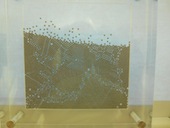Department of Physics
University of Toronto
SPEC: Special Projects
Students who have already completed at least one semester in the Advanced Physics Lab (APL) have the option of choosing a special project for one or more of their experiments.
Examples are given below, or you can propose your own idea.
If your project improves an experiment for future students, you will receive credit in the experiment writeup.
All special projects must fit into the three experiment format of the lab, i.e. be assessed on the normal experiment due dates for the course. For example, if you work on a special project that is expected to take 6 weeks, you must still submit your notebook, be interviewed, and a mark assigned after the first 3 weeks; you will again submit your notebook and be interviewed and assessed at the end of the 6 weeks.
Extending an Experiment
Many Advanced Lab experiments can easily be extended.
If the extension requires further measurements using the experimental apparatus, then you should just ask to do the experiment again.
If, however, you have lots of data that you would like to understand better (either from a previous semester of this one), you may ask to do a special project to model it.
Examples include:
- Our Mössbauer experiment is designed so that the absorber can be cooled with liquid nitrogen, but no one in living memory has ever done this.
It would be extremely interesting to compare the line widths of spectra from cooled and room temperature absorbers.
- In Conductivity in Less Than Three Dimensions,
the potential produced by current flows is measured first in a rectangular thin
aluminium sheets and finally in a several centimetre thick graphite slab. Currently
this data can only be compared with the theoretical expectations in the interior
of the sheet far from the edges. The exact solution can, however, can be calculated
by solving Laplace's Equation, e.g. by an infinite array of
image sources,
or the relaxation method.
- Another possibility would be to use our Powder X-Ray
apparatus to try measure the crystallographic structure of good and bad samples from
the High Temperature Superconductor experiment.
- Could the actual X-ray spectra of our Powder and Laue X-ray machines be measured
by borrowing the X-Ray spectrometer from the XRF experiment?
- Some experiments can be done as an ultimate experiment where the goal is
to determine what is the best measurement possible with the experimental apparatus.
The student spends either two-thirds or the whole semester working to fully understand
the relevant physics, to determine the best results possible for the experiment, and
to explore new measurements possible with the equipment. For example, how well can
the Fine Structure Constant be determined by the Compton
Cross Section experiment?
You may have your own ideas, or just ask the Lab Coordinator about the many
possibilities.
Redeveloping an Existing Experiment or Apparatus
- Our Raman Spectroscopy apparatus has had a major upgrade where our historic mercury lamp has been replaced with a green laser. This needs checking out and some safety protocols implemented before being made generally available. This involves some simple electronics and hardware, and then some neat Raman physics.
- Our Ultrafast Fibre Laser apparatus is almost working.
Developing a new Experiment
Modelling Physical Systems
The essence of physics is creating mathematical models of a physical system,
making experimental measurements on that system, comparing the measurements and
the model, and then improving the model or experiments. There are many physical
systems that are fun, and very educational, to investigate. In some cases
the investigations might even contribute to publishable results. Here are
a few possible examples.

ROMP Magnetic Pendulum
Every physicist learns about simple pendulum, but what happens if we play
with the potential?. The ROMP
Magnetic Pendulum is a loosely-hung rigid plastic rod with a small magnet
at the end. When just under the influence of gravity, the ROMP
oscillates as a normal pendulum, but when small magnets
are attached to the base the motion changes dramatically.
This multimagnet arrangement is too complicated to start with, but it would be
interesting to just see if we can quantitatively measure and model the ROMP with
just a single magnet either increasing or
decreasing the local potential. We want to go beyond
simple qualitative
modelling of the potential to quantitatively comparing the modelled motion with
video data.

Atomix
Atomix was created by Canadian artist François Dallegret in 1966, reportedly as an educational physics toy.
Atomix uses a layer of 6000 stainless steel balls to demonstrate two dimensional crystal formation with grain boundaries and defects, but what is more surprising is the "gas" of balls levitating above the "solid" crystal.
Unlike the ROMP, where magnetic forces are intentional, the appearance of electrostatic forces in the Atomix is a bit of a surprise.
Can we quantitatively measure and understand what is going on? How are the the charges generated and distributed on the balls and the interior surface of the plastic?
Are other factors involved, e.g. static friction?
Last updated on 18 December 2020

